The story of Teesta

Where the Teesta grows old
The story of Teesta begins 23,386 ft above the sea-level at the Pahunri glacier nestled between the Tibet and India border. Through one arm Pahunri empties into a glacial lake called Tso Lhamo, which spills over to create the Lachen river, one of the two tributaries forming the Teesta. The other tributary is the Lachung river, which too is fed by the Pahunri glacier. Lachen and Lachung crisscross through the northern parts of Sikkim to finally meet and form Teesta as we know it.
Our journey begins at the other end of Teesta—at the point the river prepares to flow into Brahmaputra as a tributary. Or at least, that is where dawn breaks when I open my eyes during our overnight bus journey. The signboards speeding by say that we are at Patgram, in Lalmonirhat. Here, Teesta is nowhere to be seen, but one knows that the river exists on the other side of the rolling green fields, just beyond eyesight. Stone crushers—big rusting machines surrounded by smooth white and grey stones—parked for the night flanks either side of the road. Trucks full of river stones, quarried on the other side of the border, come in from India and are dumped here. These are then broken into the pebble-sized pieces needed by our ever-hungry construction industry. Tall piles of rough-cuts, some as high as trees, dot the fields, making artificial hillocks.
This particular landscape follows the Teesta through Burimari in Bangladesh, across a man-made political border and into the district of Changrabandha in India. Once we fight through the nightmarish land ports on either side (the Bangladeshi one is way worse) and cross the no-man's-land, the only thing that really changes immediately are the shops. On the Bangladesh side of the border, the shops are regular affairs—you have a guy frying piyaju, one or two dingy hotels for a quick meal, and your mama selling tea in rickety stalls.
Compared to this, Changrabandha, on the other side, is a festival. The make-shift shops have proud window-displays of fat bags of Lay's and big bars of Cadbury's. Everything is draped in flower garlands, be it of fluorescent fabric or fresh hibiscus and marigolds. The trucks change from the yellow, snout-nosed Bangladeshi variety to big white Tata monsters wearing flower wreaths and carrying stones.
A welcome party of money-changers and taxi-drivers greet us with plastic cups of milk tea. While wrestling with the money-changers as they grab at our passports, we haggle with the taxi drivers for a car to Siliguri. A little overwhelmed by the tightening circle of people, I scan the faces, choose one I like and holler at him to bring out his car. He hops over to the parking lot and brings a bright blue Tata Nano.
And that is how we end up being taxied by a cow smuggler.
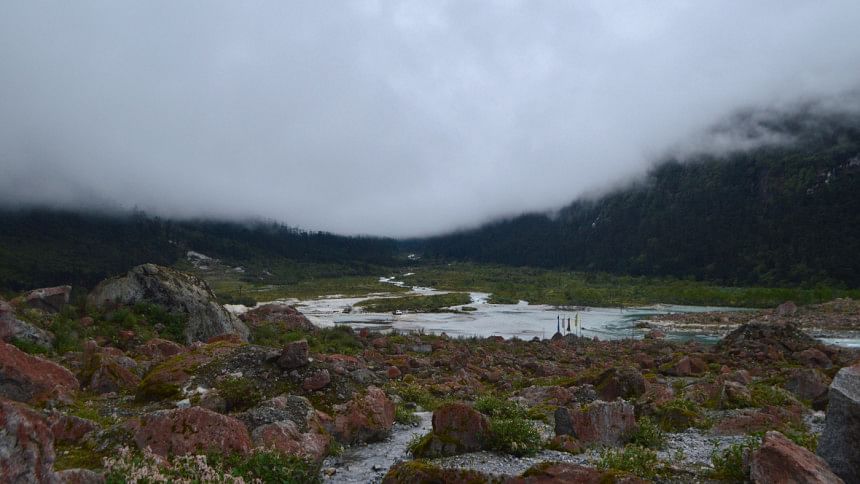
Where the Teesta belongs to both sides
"I've been a taxi driver only since Modi came into power. I used to ferry cows across the river to Bangladesh, but I stopped because there are mobs out to kill people like me," explains our driver Uttam*.
We are driving through the district of Jalpaiguri. Green rice paddies line the roads—the bounty of Teesta's waters irrigates the land here. The reformed cow-smuggler continues to give us insider knowledge about international cow smuggling. They bring in cows and calves to India during monsoon when it floods in Bangladesh, he says. These are reared in India, and then smuggled back to Bangladesh just before Eid-ul-Adha.
"However, winter is the best time for doing any business because there is poor visibility and border guards cannot see us. We put the cow on a boat and cross the river. The river is very narrow and shallow during this time," says Uttam.
While we don't go into details, flash-floods, winter droughts, and cow-smuggling are all intrinsically linked to Bangladesh's age-old tussle with India over Teesta's waters. The dam that most affects Teesta's water-flow in Bangladesh is Gazoldoba barrage, located east of Siliguri. During monsoon, the barrage lets loose—similar to what Farakka dam is doing at the very moment—flooding northern Bangladesh. During periods of drought like in winter, the dam's gates stay tightly sealed. Three decades in, the two countries have not yet figured out how to share water equitably. Even as recent as on September 10, Prime Minister Sheikh Hasina told the parliament that she will be seeking a Teesta water-sharing agreement during her upcoming visit to India this month.
Meanwhile, the people continue to suffer. Last April, Star Weekend interviewed fishermen and farmers and found that they routinely lose homes and livelihoods to flash-floods, and starve during droughts. "Over the last 15 years, I had to change homes 11 times. During every monsoon, Teesta swallows my residence and most of my belongings," a fisherman had told our reporter. Cow-smuggling into India happens during these seasons, when the farmers and fishermen have no homes to keep their livestock in, or no fodder to feed them.
Uttam swears that he is now a reformed cow smuggler, but it's clear that he sorely misses the thrill of crossing the river illegally. Every second thing he sees and hears reminds him of his old days. Two female BSF soldiers crossing the road make him launch into a story of how there used to be no female officers before, and that when the BSF came to raid villages, smuggler families used to send their women to face the male officers, allowing the men to escape. "That is not possible now because the female BSF can arrest our women," he rambles. He is like a recovering addict spiraling at every whiff of his drug. For Uttam, Teesta holds no borders—it is his to ply across as he wishes.
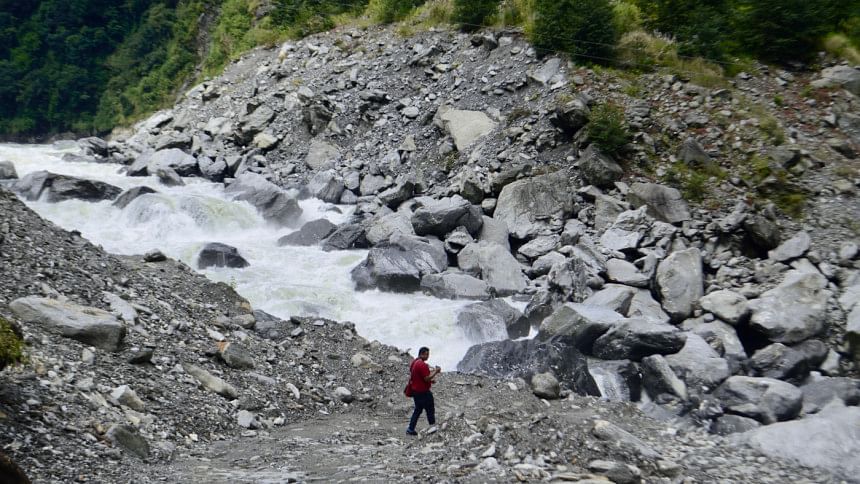
Teesta between the mountains
The Teesta disappears from sight after Jalpaiguri and does not appear until later in the afternoon, as we take the road leading to the North. At Jalpaiguri, the Teesta flows sluggishly, snaking its way through large tracts of char. When we meet it again at Sevoke, Darjeeling, all heads in the car turn towards it. It is gushing and emerald green, flowing between towering mountain cliffs. All around is lush tropical vegetation—on one side of the river is the Gola forest, and on the other, the Mangpong forest. Before long, the Coronation Bridge looms into view. The colonial-era bridge's white massive arch stands with legs on either side of Teesta. Researcher Gauri Noolkar-Oak writes in her essay "A Tryst with the Teesta" that the bridge had to be built in one tall arch because the torrential flow of the river made construction of pillars in the middle of the river impossible.
But that was before the dams, of course. At least three large hydroelectric projects and numerous smaller ones dot the Teesta, beginning from the Teesta barrage in Bangladesh, till its roots in Sikkim. We first see one of these projects with our own eyes at Kalijhora—the Teesta Low Dam-IV, which, completed in 2016, can churn out a total of 160 MW for the West Bengal grid. Compared to other upstream dams, this is considerably small, but is still a sight to behold. A shelf of water hangs ominously over the concrete wall of the dam, and the river we were marveling at up until now, is merely a thin rivulet compared to what lies on the other side. The occupants of our jeep request a toilet break at a roadside dhaba and we take the chance to take photos of the swelling green Teesta.
But soon enough, there is another dam— our jeep is now approaching Kalimpong when the Teesta Low Dam Hydro Electric Project Stage III comes into our line of vision. By this time, we have crossed enough dams since our journey started—four to be exact—and nobody lifts up their heads to peer out the window. This too is a rather small dam, they say, only generating 132 MW for the grid. If a small dam can impress and intimidate, I am curious what a big dam would look like.
Dams and hydel projects will feature frequently in our journey. During his 25-year-tenure, former Chief Minister Pawan Chamling approved over two dozen such projects, the media reports. The total projected capacity of these dams would be 5,494 MW—and the electricity is almost entirely slated for export outside of the state. Literature states that Sikkim's own demand for 2015-2016 was only 130 MW.**
The construction of so many upstream dams spells doom for downstream areas like Bangladesh where the Teesta already exists as a dry canal, multiple researches have observed. The more water is held back upstream, the less will be received in downstream areas. For example, in 2014 a researcher from Vidyasagar University analysed two decades of data and found out that Gazoldoba barrage is right now being able to release half the water that it used to. How much less water shall Bangladesh receive if more dams are built?
We get a glimpse of this future at Chungthang two days later. After a tummy full of steaming momos and a good night's rest at Gangtok, the dreamy mountain capital of Sikkim, we are en route to Dzongu Lepcha Reserve, when we come across the 1200 MW Chungthang Teesta State III Hydropower Project. Pulitzer Center called this project the former Chief Minister Pawan Chamling's "prize jewel". "It will generate 15 times the 80 MW electrical demand of Sikkim. The power generated is designed for export to appease the growing electricity demands of greater India and provide revenue for the Sikkim government," the article published in 2014 states. The project has also been criticised for not having a fish ladder, and impeding the movement of migratory fish like snowtrout, which is already a vulnerable species.
Our Jeep driver deliberately stops at a point where we can get an elevated view of the vastness of the reservoir. There is even a tiny stall selling tea and steaming bowls of soupy Maggi noodles garnished with tomatoes and coriander. The intent is quite clear—this is a rest-stop where one can slurp on noodles while taking in the breathtaking beauty of the man-made reservoir. Everyone takes out their phones and starts snapping away. Questions about the environmental concerns of dams, concerns about how large dams upstream are affecting Bangladesh's own Teesta waters, disappear in the apparent tranquility of the experience.
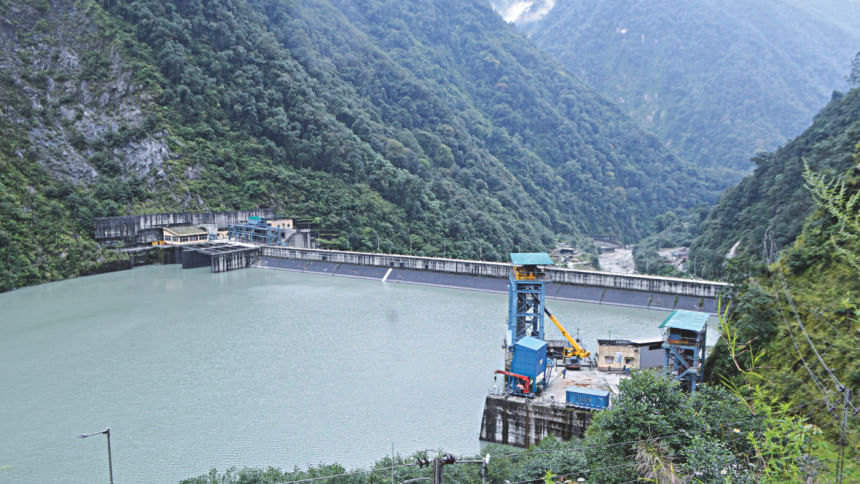
Where the Teesta is worshipped
It is ironic that we stop to appreciate the Chungthang reservoir on our way to "experience" Lepcha culture. The Lepcha indigenous community has been central to the movement protesting Teesta dams in their homeland of Dzongu, which also includes the UNESCO World Heritage Site Khangchendzonga National Park. The community organised to form the Affected Citizens of Teesta, whose leaders Dawa Lepcha and Tenzing Lepcha went on a hunger strike for 63 days in 2008 to get the hydro-electric power projects scrapped.
The indigenous activists point out that most of the land being taken for hydel projects belonged to Lepchas. Although the activists succeeded in stopping several projects, they could not stop the Chungthang dam from being built. Another project—the 520 MW Teesta Stave IV—is still hanging in the air. 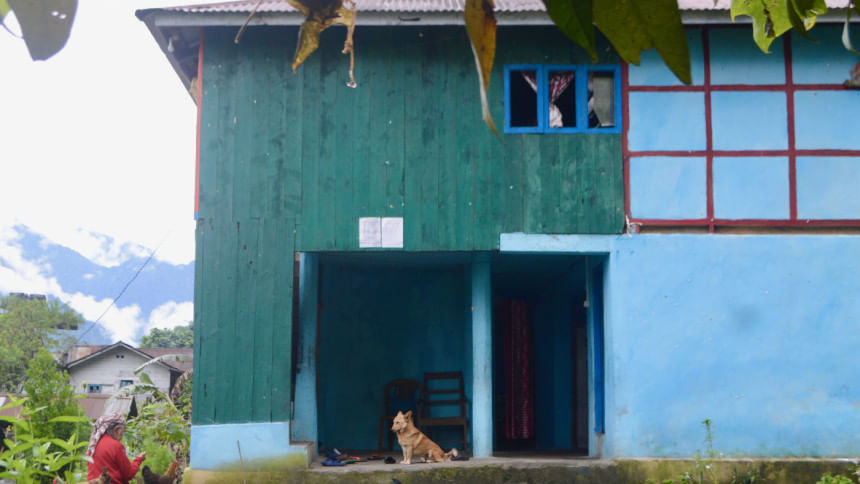
Through the course of the next day, we learn that for the Lepchas, environmental activism is not just a civil rights issue, it's also religious. The community practices animism, which is the worshipping of nature itself. Every creature is revered, and nothing is too insignificant—even the smallest cockroach is respected. Lepchas believe cockroaches helped invent chee, the local millet wine. The community's heavenly realm lies beyond Kangchenjunga where the earth's spirit mother Itbumu resides. Their motherland Dzongu is the Earth's primordial soup where genesis takes place. Similarly, the Teesta river was created as a result of the romantic union of two heavenly rivulets.
It is during our journey to Dzongu that we are truly made to realise why Teesta is considered divine by the Lepchas. Gravelly uphill mountain roads run neck-to-neck with the Teesta at its most furious mighty self. Up until now, the mountainous Teesta had always remained far below, removed from us by several kilometers of cliff-face. But here, we are face-to-face with a mountain river. The terrain is built of large, loose rocks, none of which are too big for the frothing, gushing rapids which seem strong enough to sweep away homes, and definitely, puny humans like us. Our Jeep totters in the narrow space between the riverbank and a cliff, but it can only get us so far.
The Boleros stop in front of a long bamboo and cable bridge. We head towards the village of Tingvong, where we park for the night at a Lepcha homestay.
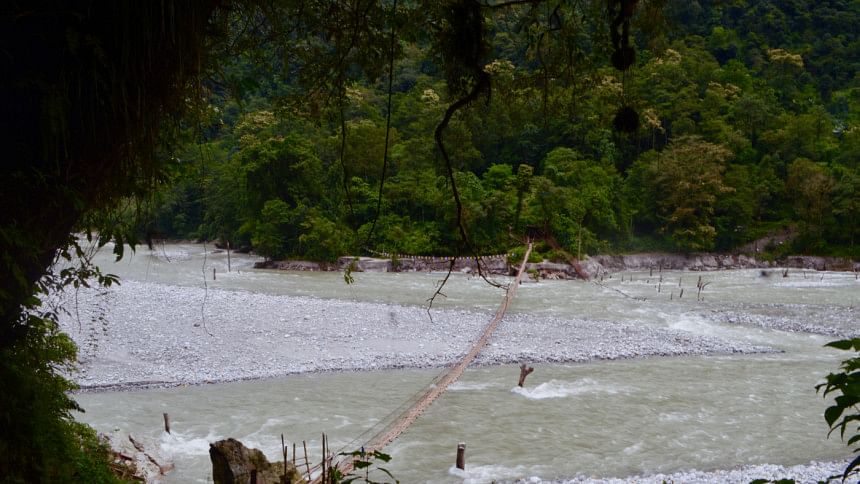
"The car stops here. You have to cross the Teesta to get to your destination," we are told. Some of us feel a rush of thrill at the prospect of having to do a tightrope walk on a bamboo bridge; others get cold feet. Ahead of us lay the cloud-shrouded peak of Mount Pandim, and below our feet, foaming water. It has begun to drizzle, bringing with it gentle winds that rock the bridge carrying unstable novice humans, almost as if to send a message—damn it however much you want, but here in the mountains, the Teesta is god.
Once we cross the bridge though, we enter into a land straight out of mythical folk tales. A small jeep waits to take us to our village. Everything is bigger, greener, and we are at our smallest. Ferns grow to the size of palm trees, the roads are lined with fat clusters of periwinkle blue hydrangeas and the largest orchids I have ever seen. Our jeep has to pass through several waterfalls and mountain springs—at some points, we cling onto our lives and gear over them, and at others, we drive under them, getting showered with fast-falling water in the process. Next to a stream is a modest temple with a prayer wheel; each time the waters hit the wheel a prayer is sent to the gods. This is the land hidden on the other side of Teesta.
Our night ends with warm chee drunk through a bamboo straw, accompanied by a meal of rice bamboo shoots and fern stir-fry, shared with the Lepcha family hosting us.

Where the Teesta began
The journey ahead to the source of the Teesta takes another two days. We drive away from the forests of Dzongu towards Lachung, a small tourist outpost where we stop for the night. There is no electricity in the entire village—this, in a state that boasts the production of more electricity than it needs. Our gentle Sikkimese hosts try their best to accommodate us in the light of the single lightbulb being powered by the IPS. The town is pitch black, and the only noise comes from the Lachung river angrily gushing by. Here, the Teesta exists as its glacial upstream predecessor.
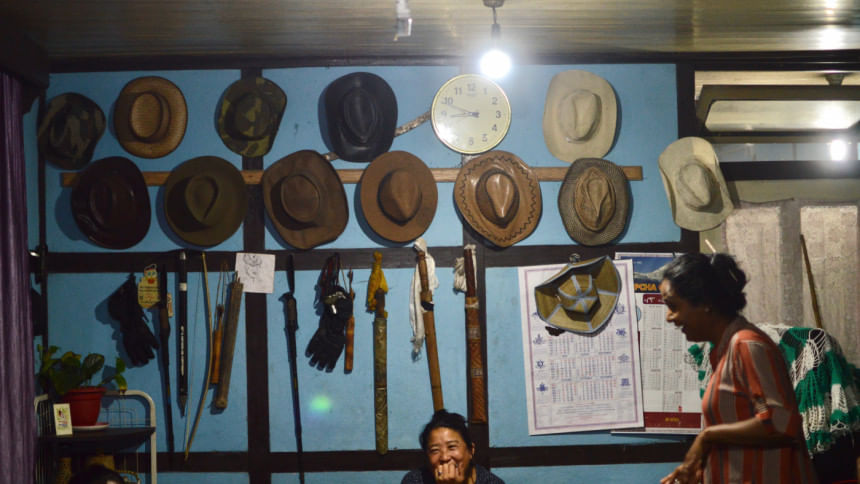
An hour before dawn, we get dressed in complete darkness, fumbling with our clothes and bumping against furniture, before hitting the road. The first rays of the sun strike the snowy peaks of Mount Katao turning the whole sky brilliant white—our eyes, having been in darkness for hours, take a moment to adjust. As our jeep climbs the mountainous road towards the foot of Mount Pahunri, the landscape changes fast. At one moment we are crossing jewel-green temperate forests, and then suddenly, the ground gives way to craggy red rocks, alpine fir trees and rhododendron bushes. A thick blanket of fog envelopes everything—the car, the road, us. I see a red panda crossing the road but my husband scoffs it off as a common Himalayan weasel.
Just as suddenly, the trees disappear. We are surrounded on all sides by snow-covered peaks and the only vegetation are small shrubs growing between lichen-covered rocks. With the absence of forest cover, the sun beams on unhindered. At this point, the road stops, and cars can go no further—it is locally known as Zero Point. To our right lies Mount Panhuri, and before us lies the Teesta in its purest, most nascent stage, flowing as a happy gurgling stream coming from the mountain crevices. This is where the story of this politically wrought river begins. At this point, the river has no idea that it will face multiple dams, be the subject of more than three decades of diplomatic wars, lose its ecology and its people, that it will be let down by states and governments. Here it is barely ankle-deep, barely rising enough to cover its stony riverbed. What it does not know is that by the time it reaches Bangladesh, it will be ankle-deep again in places, because it will not be allowed to flow. Watching the bubbly little stream set against snowy mountains, one truly fathoms the extent of human destruction.
*The name has been changed to preserve his privacy.
**As stated in the essay "Sikkim's Hydel Journey" published in The Birds Have Lost Their Way (2018) by Lokta Books in Sikkim.





Comments